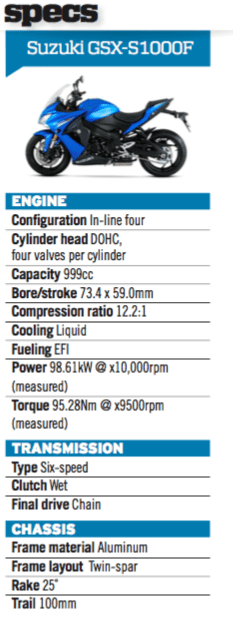There’s something enormously satisfying about telling people to get stuffed. About bucking the trend and forging your own path irrespective of the status quo. Suzuki has done that with the GSXS-1000F and it’s not their first time. This all new mid-faired version of the 2015 GSX-S1000 is built around the engineering genius of Suzuki’s K5 GSX-R1000 engine and designed as a “pure sports roadster”. Like the naked model, it benefits from a semi-upright riding position and the addition of a simple and effective 3-stage traction control system. But unlike its sibling the GSX-S1000F pushes the boundaries of design to create a motorcycle that will long be remembered, and not just for its looks. This seemingly mild mannered machine is nothing short of a missile on the back roads, and while it may meet its match against the more uncomfortable superbikes on track, they’ll surely meet theirs on 90% of the roads we ride.
Rather than target a market that they have already covered Suzuki has chosen to create a machine that will appeal to motorcyclists who have enjoyed their time on unforgiving sportsbikes, and are now looking for something that can be ridden at either a leisurely or rapid pace without compromising on comfort. You could be forgiven for classifying the GSX-S1000F as a sports-tourer at first glance, that is of course until you observe the sleek and compact sub-frame which is no more appropriate for carrying pillions or luggage than any other modern superbike. Upon close inspection you’ll see that the big clear screen is firm and well positioned, and there are also small spoilers flanking either side of the tank to redirect wind past the legs at speed. A broad low profile tank reduces the distance between the seat and the ‘bars and is also easy to grasp for more spirited riding; the finish is as clean and compact as any high quality Suzuki product I’ve known, and the black rotar-esque mirrors actually work which is a welcome change from most sportsbikes.
Gone are the days when you had to hold the clutch in and keep your finger on the button until the engine spluttered into life. With Suzuki’s instant start system just press the ignition and the crank continues to spin on until the engine fires up. The backlit dash is easy to read without having to drop your chin, and also comes with an option to display the fuel range which is a win for common sense. For those who want to customise their GSXS-1000F, there’s a great range of genuine accessories available directly from Suzuki that include heated grips, a seat tail cover, tank pads and a variety of trick looking decals.

When you throw a leg over it you quickly realise it’s too comfortable to be a supersport and much too low to be classed with the Super-Nakeds so yes, the term “pure sports roadster” is apt. Cruising along at urban speeds is no problem at all for this motorcycle, with its ultra smooth 1000cc engine and user friendly riding position. The seat height is low at 810mm, and while my legs did start to protest the compact position on long highway journey’s over an hour, I’m sure riders under 175cm tall will see this as a great attribute. Most of the mumbo is focused squarely at the low- to mid-range, but anyone who purchases a GSX-S1000F with the sole intention of getting from A to B is really missing out. That’s not to say that this bike is unwieldy or unsuited for daily commutes, quite the opposite, it’s just that any litre class bike regardless of the fuelling or electronics package will be operating at a fraction of its potential in stop-go conditions.
It incorporates a retuned version of the very same K5 GSX-R1000 engine that was worshipped by many as one of the marque’s greatest recent achievements in road legal motorcycle engineering. I know what you’re thinking, that engine is nigh on 10 years old now and very much out of date. Well, this may be the case but the way Suzuki has reinvented it you wouldn’t know it. Several aspects of the 2005-2008 GSX-R powerplant have been overhauled to ensure that the GSX-S1000F engine characteristics are just as suited to city streets as they are twisty mountain roads. The pistons have been lightened without compromising durability, and the cam shaft has been altered to optimise the valve timing. There’s extremely linear power delivery across the rev range and heaps of twisting force in the low to mid-range. The throttle response and pick-up from a standing start is instantaneous, and I didn’t notice any lack of puff until we got high into the gears and upper rev range. The long stroke has been retained for an optimal compression ratio, and although there is a downside in compromising top end zing, notably in 5th and 6th gear, the drive is so crisp and seamless under 6000 rpm that it couldn’t be better suited for road use.
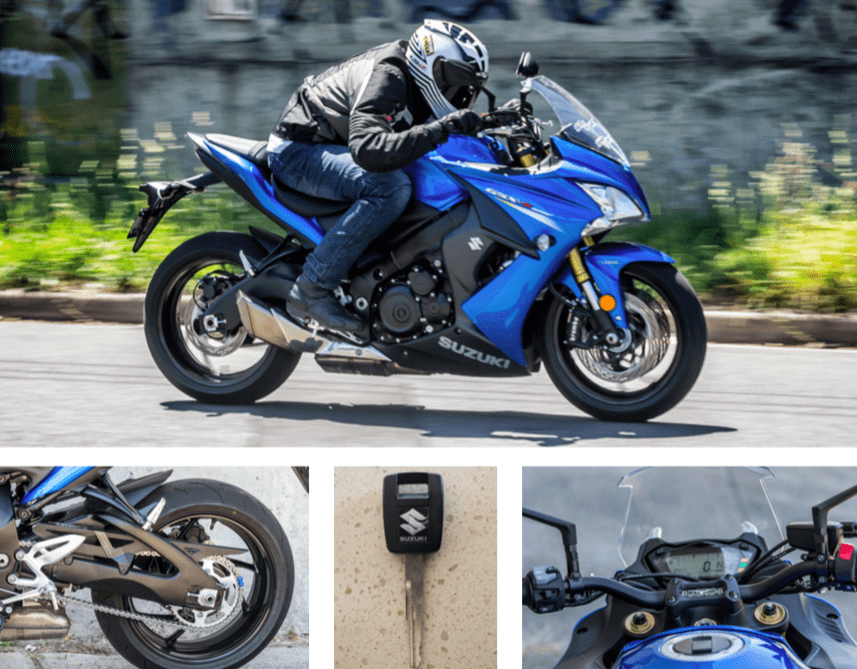
Suzuki’s dual throttle valve system has also been upgraded for more efficient combustion and smoother power delivery. The patented exhaust tuning system operates a butterfly valve in accordance with engine speed, gear position, and throttle position to produce a fat band of torque in the low to mid rpm range, with the added bonus of a healthy exhaust note. Like many big bore in-line four-cylinder engines, it sounds a bit like a bag of cats being kicked down the stairs, but after a while you become quite attached to the rising cacophony and find yourself looking for any excuse to hear it open up. In fact, such is the quality of the 4-2-1 exhaust, I wouldn’t even be tempted by an aftermarket system.
The radially mounted Brembo monobloc calipers and 310mm twin discs have top notch stopping power, and good initial bite. For trail braking and modulating speed on rough surfaces they provide excellent feel, and there’s never any pulsing from the front ABS which is permanently on standby. When the rear brake ABS is activated it continues to slow the bike down at a rapid pace while smoothly modulating rear wheel lock. The front stoppers did get slightly spongey after an episode of very hard repeated braking in hot conditions, but they returned to their previous high levels of efficiency after around 10 minutes or so of cooling down. This may have been purely a matter of the system needing to be rebled.
Despite racking up around 200km scouring the mountainside for twisted sections of tarmac, at no stage during the day’s ride did I really feel uncomfortable. I’m accustomed to bone-jarring commutes through suburbia to reach back road bliss, and ordinarily would be begging for a break to stretch my legs, but the GSX-S1000F is surprisingly comfortable thanks to the raised Renthal “Fat Bars” and low-set footpegs. The relaxed ergonomics also make it easy to transfer weight from the arms to the footpegs, which in turn makes it easy to move about on the bike – unlike modern supersports that more often than not have me slithering all over the tank just to take the pressure off my wrists.
The MX-style bars deliver plenty of leverage to muscle it through tight traffic, or to change direction quickly on twisty roads. There’s also a slightly greater wheelbase and rake compared to fully fledged superbikes. This helps the bike retain stability when tipping in and at high angles of lean without making it difficult to turn.
Once you get it up into the hills this motorcycle demonstrates just how balanced and well proportioned it is. The 43mm KYB fork transmits excellent feel from the front end, and the suspension set-up is light enough to soak up all the inconsistent road conditions without diverting the bike off line or feeling vague or sloppy. The superbly balanced chassis combined with a 2015 GSX-R1000 swingarm make this motorcycle eminently useable in less than perfect road conditions, and still very capable of holding its own with modern day supersport machines. It’s extremely predictable and really comes into its own on winding roads where you can hang off to your heart’s content and be confident that its gixxer DNA has you covered. The odd track day is certainly not out of the question on this beast either.
As a package it delivers an extremely fun but useable motorcycle that is perfectly suited for riders who have owned pure sportsbikes in the past but are looking for something that doesn’t flare up the arthritis or creaky bones on the ride to the twisties. Yes, I’m talking about older motorcyclists. Hey, don’t shoot the messenger, Suzuki makes no secret that its target audience for this model is over-40s – and it’s been done so perfectly that there will be plenty of much younger buyers who become enamoured with the sheer rideability and simply choose to grow into it.
Suzuki has edged closer to the tech-table with the addition of traction control to make the bike more versatile and competitive. And after a proper blast on the back roads, I was mighty impressed with the system. Power delivery to the rear wheel is adjusted via alterations to the ignition timing and air feed after comparing front and rear wheel rotation speeds. With sensors checking this 250 times per second, it’s a smooth process that’s barely noticeable unless you’re on the side of the tyre and opening the throttle like a ham-fisted greenhorn.
The system can be operated on the fly and the ECU remembers the setting, even after the ignition is switched off. With the traction control disengaged, the rear tyre will squirm around under the load produced by the stonking 1000cc engine. This is the most fun setting to ride with, and really emphasises the punch of the torquey motor.
At level 1, power delivery is firm but regulated to provide a smooth, confidence-inspiring application that still allows the rider to scratch with the best of them up in the hills. While some wheel spin is definitely possible, it smooths the ragged edge without compromising the riding experience.
Level 2 is excellent for use on compromised road conditions or in urban environments, and sufficiently moderates the power delivery from a closed throttle so you can afford to be a bit choppy in heavy traffic without consulting a crystal ball. It’s also highly suitable for new or less experienced riders that want to save some excitement for later in their ownership days, or those who are still getting Sport Standard Suzuki’s GSX family The front fairing adds 7kg over the naked version (GSX-S1000), and receives 20ml more oil in the forks to accommodate this. Suzuki has designed the front fairing of the GSX- S1000F to add downforce at speeds over 200km/h, just in case you should want to go there! familiar with the bike. Level 3 is best suited to very wet or damp roads which otherwise would result in the rear end spinning up all over the place. All three modes do an excellent job of liberating speed from the engine without compromising rider safety and each have their place in providing greater control and hence improved levels of confidence.
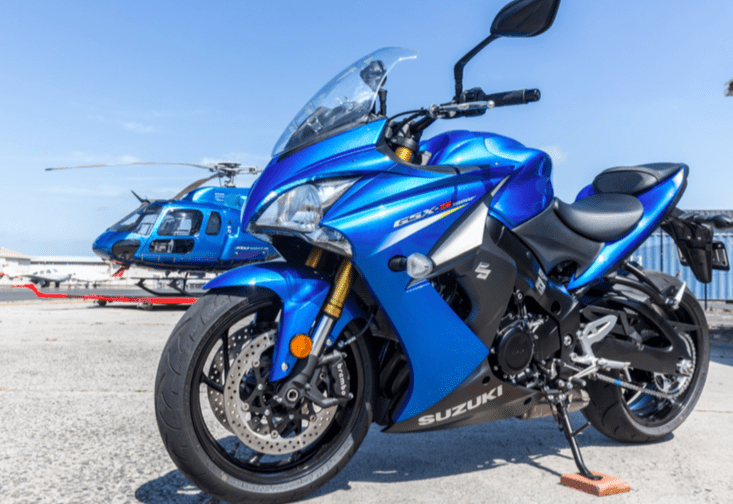
At the peak of the day I had the time of my life piloting this bike through the rolling hills, and through a number of sections of gravel-smeared tarmac level 2 was a saving grace. I switched between level 1 and level 2, not just to deal with inconsistent road conditions but also to conserve energy when I didn’t feel like investing as much concentration on applying the throttle. Being able to select between three basic modes to match the riding conditions or your own frame of mind is a luxury that I believe every rider will appreciate. The GSX-S1000F has just the right amount of liveliness to differentiate itself from competitors in the fun stakes, and the quality of the electronics package demonstrates that Suzuki is well on the way to its next game-changing model.
There’s virtually nothing to fault in the ergonomics, chassis balance or power delivery, but there are a few modifications that would help push me over the line for the $15,790 plus ORC price tag. Although the gearbox is very slick and light, a quickshifter for clutchless up-shifts would be a welcome addition. Also, Suzuki stipulates that the standard brake hoses are due for replacement every four years and this would be a good opportunity to invest in some braided steel lines.
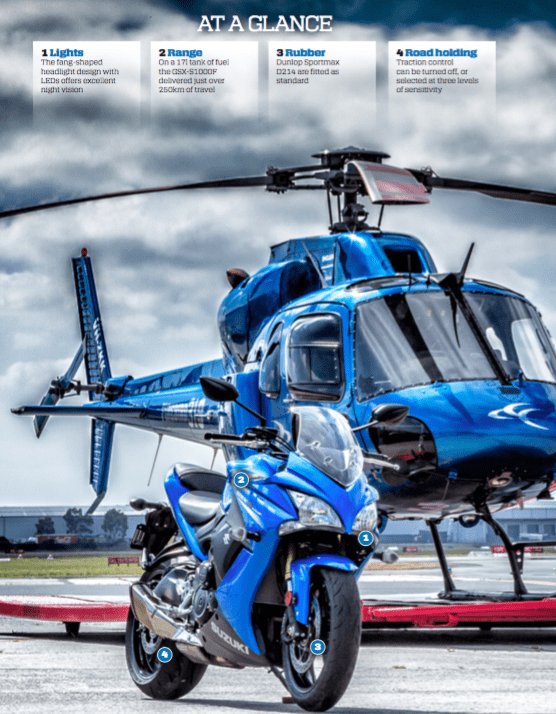
Overall, this bike’s mild, unassuming demeanour is one of its greatest assets. It allows you to blend in, and adds to the sense of reward when you outshine those technicoloured race replicas in the road-scratching stakes. Sure the finish and colour scheme is attractive to the eye, but it’s not a look at me bike like the exotic European adventure-tourers, or the big-bore supernakeds. The humble exterior belies a howling beast of an engine just waiting to be unleashed on whatever section of unsuspecting winding road is available, and this is exactly as He (Osamu Suzuki) intended it. Gone are the days when you suffer through an hour or two of discomfort, or in some cases agony, before arriving at your favourite scratching roads. The GSX-S1000F makes every part of the trip enjoyable, with such effortless control as to promote the very act of riding rather than just the pursuit of suitable conditions.
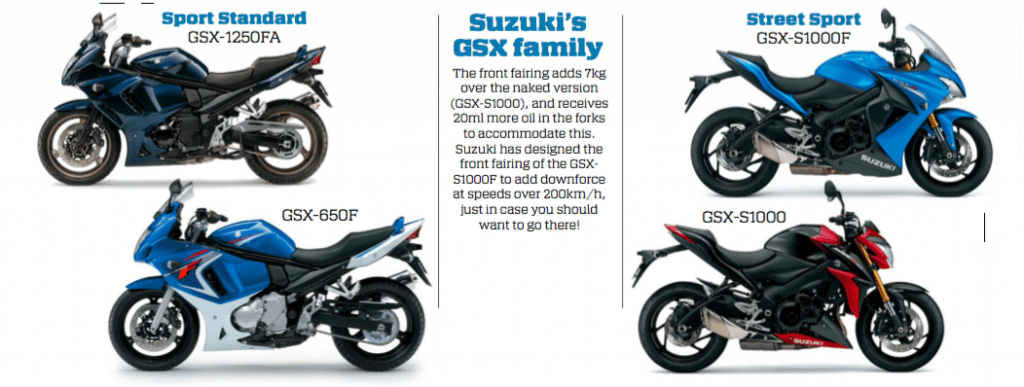
The crouching beast is reminiscent of a sharper and more aggressively styled Hyabusa, but will this edgy look conform to everyone’s taste? The short answer is no, but then again perhaps it never really had to. Mature riders are not known for their need to kowtow to popular culture, or own a bike that looks strikingly similar to every other model in the showroom. They yearn for the important things: performance and rideability at a fair price. In this, the GSX-S1000F ticks all the boxes and for that reason it will be sure to win fans among those who are ready to enjoy the comfortable embrace of the pure sports roadster.
By Paul McCann
